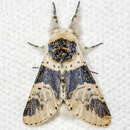Conservation Status
provided by University of Alberta Museums
No conservation concerns.
- license
- cc-by-nc
- copyright
- University of Alberta Museums
Cyclicity
provided by University of Alberta Museums
Adults are on the wing late May to July.
- license
- cc-by-nc
- copyright
- University of Alberta Museums
Distribution
provided by University of Alberta Museums
Fom the Maritimes west across southern Canada to southeastern BC. In Alberta, found throughout the aspen parklands, southern boreal forest, foothills and lower elevations in the mountains. It apparently does not occur as far north in the Boreal region as F. scolopendrina and F. occidentalis.
- license
- cc-by-nc
- copyright
- University of Alberta Museums
General Description
provided by University of Alberta Museums
A medium-sized (3.5-4.0 cm. wingspan) grey-black and white moth, with a cream or light tan cast to the white areas of the forewings. A broad black band crosses the median area of the forewings. It usually narrows in the middle, and in many specimens is divided into two wedge-shaped patches. Modesta can be separated from other Furcula sp. by the absence of yellow or gold scaling on the forewing where the lines cross the veins. Male modesta can also be separated from the other species of Furcula by the diamond shape of the laterally flattened uncus.
- license
- cc-by-nc
- copyright
- University of Alberta Museums
Habitat
provided by University of Alberta Museums
Deciduous woodland and shrub.
- license
- cc-by-nc
- copyright
- University of Alberta Museums
Life Cycle
provided by University of Alberta Museums
Adults are nocturnal and come to light. The larvae are solitary defoliators. There is a single brood which overwinters in the pupal stage.
- license
- cc-by-nc
- copyright
- University of Alberta Museums
Trophic Strategy
provided by University of Alberta Museums
No Alberta data. Elsewhere reported larval hosts include aspen poplar (Populus tremuloides) and willows (Salix).
- license
- cc-by-nc
- copyright
- University of Alberta Museums
Furcula modesta
provided by wikipedia EN
Furcula modesta, the modest furcula or modest kitten, is a species of moth in the family Notodontidae (the prominents).[1][2][3][4] It was first described by Hudson in 1891 and it is found in North America.[1]
The MONA or Hodges number for Furcula modesta is 7941.[5]
References
- license
- cc-by-sa-3.0
- copyright
- Wikipedia authors and editors
Furcula modesta: Brief Summary
provided by wikipedia EN
Furcula modesta, the modest furcula or modest kitten, is a species of moth in the family Notodontidae (the prominents). It was first described by Hudson in 1891 and it is found in North America.
The MONA or Hodges number for Furcula modesta is 7941.
- license
- cc-by-sa-3.0
- copyright
- Wikipedia authors and editors
Furcula modesta
(
Dutch; Flemish
)
provided by wikipedia NL
Insecten Furcula modesta is een vlinder uit de familie van de tandvlinders (Notodontidae).[1] De wetenschappelijke naam van de soort is voor het eerst geldig gepubliceerd in 1891 door Hudson.
Bronnen, noten en/of referenties Geplaatst op:
11-04-2013
Dit artikel is een beginnetje over biologie. U wordt uitgenodigd om op bewerken te klikken om uw kennis aan dit artikel toe te voegen.

- license
- cc-by-sa-3.0
- copyright
- Wikipedia-auteurs en -editors

